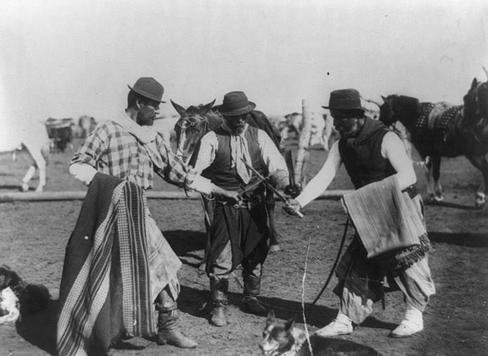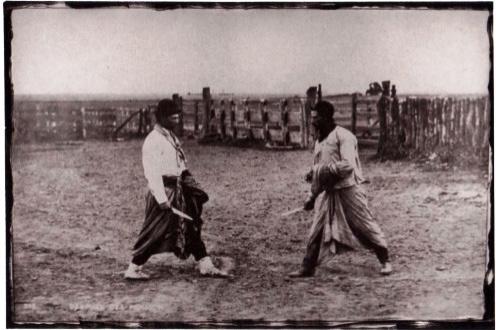
6 minute read
CROLE FENCING PROF. D. Eduardo Luzardo
CREOLE FENCING
Prof. D. Eduardo Luzardo
Advertisement
CREOLE FENCING In the fifth edition of this same magazine, «El Camino», we published an article about Spanish fencing of the 16th century, known as Verdadera Destreza. Today, we bring to the scene a curious heir to this western art of warfare, so I recommend that you read the article cited above, to see more clearly the parallels between both fencing. The figure of the gaucho, today, has reached edges of great mysticism. A tough character, who inhabited the plains and surrounding areas, in several countries of the South American continent. To imagine a gaucho is to visualize a particular and curious way of life, being semi-nomadic rural workers, they became skilled horsemen and men of character, with a great sense of honor. In the context of the campaign of the 18th and 19th centuries, the gauchos developed various tasks, but for all of them they used a common element, since it is impossible to try to reduce a concept that describes them, without noticing their main tool, the knives. The gaucho was a very practical man, who used the knife as a tool for endless daily tasks, such as feeding himself, gelding an animal or slaughtering it, as well as for the defense of his physical integrity, and in particular, for defense of his honor. Along the same lines, he used the poncho, an outfit that protects both from the cold and from the attacks of a sharp or stabbing enemy attack. In the context of certain bellicosity and belligerence where the gaucho worked, it was normal for him to inherit Spanish soldiery forms and make them his own, giving him a Creole and becoming touch. Rapier swords turned into huge knives, Spanish spears into chuzas, ponchos used as capes, bowls into hawks, duels, phrases, techniques and tricks inherited, confused and/ or perfected, constituted and shaped the great skill exhibited in combat by the agile and daring exponents of Creole Fencing. The gauchos had some tools used as weapons, among these the combat bola stood out, which consisted of three branches of twisted rawhide, with a length of almost two meters, in whose ends three balls of blunt material were nested, each one with about ten centimeters in diameter, which when launched hit and rolled up the target. Other tools used in combat were the whip, the defensive faceted poncho, or the knife and lasso. Within this weaponry, the use of white blades stood out, daggers such as the verijero knife, with a blade of about ten centimeters, used mainly to castrate cattle, or the dagger, similar to a dagger but with an edge and counter edge, made from discarded bayonets and/ or remnants of sword blades, the result was a blade between twenty and sixty centimeters long, to which they used to make a groove on the longitudinal sides of the blade, which served as indentation at the time of to cut the jugular vein of an animal that would be butchered. Another white weapon used was the caronero knife, owner of a blade about eighty centimeters long and without a hawk to facilitate the extraction of the weapon, made with the remains of swords, used mainly for hunting or to kill cattle, its name comes from of the fact that it was kept in the errand, among the caronas. Then, we can mention what is perhaps the most famous of its blades, that of the facón. The facón was a single-edged knife, with a symmetrical axis, which had a hawk or garrison, generally a straight crossbar in the shape of a cross or curves in the shape of a "U" or "S", these hawks were designed to protect the hand. After a few blows from enemy blades, the blade of this great knife could be around half a meter long, it was usually carried

across the back, with the edge upwards, ready to unsheathe in a cutting gesture. Within their arsenal, sometimes they also had the chuza, a kind of spear, armed with a tacuara cane about three meters long, to which they endorsed at its tip, a wrought iron end, or a knife or blade. shears. At the time of combat, it was common for duels to take place to see who was the most skilled knife, or to put an end to a simple discussion. The techniques used focused on the dexterous use of the knife, although many times they combined the knife with the whip, the latter held with the less skilled hand and in such a way that the hard end protrudes, the preferred weapon when one of the combatants wanted to show his strength. superiority over the other, hitting him hard with the rope or trying to mark a scar on his face with the dagger, one of those that last and humiliate for life. Another combination, perhaps the most common, was the knife in a skillful hand and the poncho wrapped around the opposite forearm, defensively, similar to the technique used by Spanish fencing with the cape and rapier. The poncho was left a final section to hang with the fringes, a tactic used to perform certain tricks, such as making the opponent step on the poncho to destabilize it, hide some movement or blind the rival momentarily with a fringe. In combat, the guard used to be with the skillful leg forward, the body outlined forward and a rather low center of gravity, with semi-flexed knees, taking care of the balance, with the weight distributed on both legs and a maximum width and width separation. half shoulders, a position that allowed them to be ready to act forward, backward, or lateral dodges. The movements were similar to those of a current boxer, adding agile jumps to "dodge the bulge", that is, avoid the fast enemy blade. The attacks consisted fundamentally of "planchazos", blows with the side of the blade, used to show off superiority in combat while dealing a strong dry blow, effective but without a cutting wound. Also of the fearsome "hachazo" or "God save you", a cut aimed mainly at the head, struck with considerable energy and using the edge of the blade, or "the one that lowers the guts", a cut aimed at the middle zone, risky of strike but extremely lethal, to this we must add cuts to the face and rapiers or stabs. In this fencing tricks are also observed, some already described, received curious names such as the "flecazo", which sought to blind the opponent with the fringes of the poncho, or make "step on the poncho", and then make the opponent fall. Tactics such as feints or blinding the rival through the ground throw could also occur. The gauchos were men of extreme skill in the handling of knives, in order to achieve this skill, they practiced since they were children through games, blackening their index finger to mark a simulated cut, or delimiting an area as a quadrilateral to enhance the qualities needed in combat. Undoubtedly, fearsome exponents to face and deal with, which permeated the culture of their areas of influence, leaving clear marks that persist to the present day, for example, in the Creole handsomeness of countries like Uruguay or Argentina, where until the previous century, The pastures had been exchanged for cement and the ponchos for sacks, to practice duels protected by republican norms. The so-called Duel Law, in Uruguay, was repealed in 1992, while in Argentina, the last public duel was probably in 1968.

Gauchos from the Río de la Plata, in "honour duel", at the end of the 19th century.











